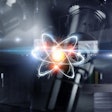Lung cancer remains by far the leading cause of cancer death in the U.S., with an estimated 171,600 new cases reported in 1999, according to American Cancer Society statistics. The global view is darker still, with rising smoking rates expected to lead to higher lung cancer mortality in many developing nations.
Because "the silent killer" often remains asymptomatic until it becomes untreatable, lung cancer is deadlier than other forms of the disease, with a five-year survival rate of only 14%. In an effort to improve the odds, the emphasis in recent years has shifted to early detection and treatment, especially in high-risk populations such as older long-term smokers. As a result, more research has been focused on the classification of solitary pulmonary nodules (SPNs), important markers for lung cancer that account for an estimated 20% of all new cases.
Since over half of the 130,000 SPNs discovered each year in the U.S. turn out to be benign, less expensive and noninvasive alternatives to the current treatment standards, CT-guided biopsy and surgery, are needed to separate the benign from the malignant, and avoid unnecessary surgery. The issue is an important one -- clinically, ethically and financially -- due to the costs and risks associated with surgery, and the need to ease the worries of patients who suffer while doctors "wait and watch" indeterminate nodules.
Two new techniques for classifying SPNs, presented at the 1999 RSNA conference in Chicago, are representative of these efforts. One involved a study of SPNs identified in contrast-enhanced CT images of nine patients at the University of California, Los Angeles (UCLA). The other, a larger study with more than 100 patients, used technetium-99m depreotide SPECT imaging to evaluate SPNs in more than 100 patients at multiple sites in the U.S.
Spiral CT imaging with image analysis has several advantages over other methods of classifying SPNs. Not only is spiral CT considered the next logical step after finding a nodule on a chest x-ray, it is considerably cheaper than PET or SPECT techniques. CT can also spot nodules as small as 1 mm, while nuclear medicine techniques work better with SPNs of 1-3 cm or larger.
However, spiral CT alone yields a high percentage of indeterminate diagnoses. In order to improve the diagnostic value of the technique, the UCLA researchers set out to determine whether combining contrast enhancement with size and shape measures could accurately classify SPNs imaged with spiral CT, according to Michael McNitt-Gray, Ph.D., a researcher involved with the project.
"We asked the question: is there more to it than just contrast enhancement? Is there more to it than just density...and shape? Is there somehow a way to combine the individual descriptors into a more complete analysis of the nodule?" he said.
Building on earlier studies at Cornell University and elsewhere, the UCLA researchers used a series of high-resolution images obtained from nine patients presenting with SPNs, both before and at several time intervals following the injection of a contrast agent -- a technique that generates an indirect measurement of the nodule's vascularity.
The nodule contours on the resulting images were segmented to create corresponding two- and three-dimensional regions of interest for each image series. The 2-D images were evaluated for texture and intensity based on the change in Hounsfield units following contrast enhancement, using mathematical formulas designed to quantify the relationship between the intensity and the spatial distribution of those intensities within the nodule. Using another set of formulas, the 3-D images were evaluated for the degree of sphericity characteristic of benign, calcified SPNs.
The results were impressive: While contrast enhancement was able to classify eight of the nine cases correctly, both the sphericity and the combined calculations correctly identified all nine. The method has been used to evaluate more than 30 patients since the initial study was published last year, with equally promising results, according to McNitt-Gray, who said the research continues as qualified patients are found. The unpublished results of the expanded study show the combined techniques to be about 98% sensitive, McNitt-Gray said, with specificity of 58%, and overall accuracy of about 77%.
"Our results using contrast enhancements combined with a 3-D measure of shape are very good predictors," he said, "and gave some improvement over the kinds of results we'd seen with contrast enhancement alone."
The SPECT study is based on the known affinity of various malignant neoplasms for peptide analogs of somatostatin, in this case, Tc depreotide (NeoTect) manufactured by Diatide of Londonderry, NH.
The study was conducted to meet the Food and Drug Administration's requirements as a multicenter phase III trial, and was completed in December 1997. Diatide submitted a new drug application for NeoTect in June 1998, and the FDA cleared the product for marketing in August 1999.
In the study, 114 patients with SPNs of 6 cm or less that lacked a benign pattern of calcification underwent SPECT imaging with NeoTect, and subsequent histologic examination. The images were examined by three nuclear medicine specialists and scored as positive or negative based on the presence or absence of radiographic activity in the nodules.
The study correctly identified 85 of the 88 individuals with histologic results indicating malignancy. Overall, sensitivity of the technique was 96.6%, with a specificity of 73.1%. The authors concluded that Tc depreotide scintigraphy was a "safe and useful method for the noninvasive evaluation of SPN," with results comparable to those reported from FDG positron emission tomography.
Dr. Hirsch Handmaker of Healthcare Technologies, a consultancy based in Phoenix, is a Diatide board member and one of the researchers involved with the trial. He said he was pleased with the results, and optimistic about NeoTect's promise in classifying SPN.
"The goal was to prove it was safe and effective, and would reduce the number of unnecessary surgeries, or conversely make sure that people with cancer got to surgery," he said. "The study sort of proved that and made us happy. I think NeoTect will find its role in day-to-day clinical medicine."
Dr. Barry Siegel, director of nuclear medicine at the Mallinckrodt Institute of Radiology in St. Louis, agreed that the NeoTect results were promising, but said it was too early to tell how effective the technique would be outside the controlled circumstances of a trial -- and compared with nuclear medicine's current standard, FDG-PET.
"Given that it's currently acknowledged that FDG-PET is as close as possible to the best technique for distinguishing benign from malignant SPN -- short of having the nodule out in a pan -- there needs to be a head-to-head comparison of NeoTect SPECT with FDG-PET," Siegel said. "Simply taking the results of one study and saying the results are similar to what's reported with FDG-PET is not the same as doing a carefully controlled study."
Diatide's director of marketing, Harry Atkins, said the company had no plans to finance a study of the two techniques, due to cost considerations. Handmaker, however, said he supports such a study, even proposing to take it a step further.
"The real study we'd like to see done is a CT, NeoTect, FDG-PET combination," Handmaker said, "and we're actually writing a grant to do that."
For now, Handmaker said NeoTect SPECT imaging offers several advantages, including a price tag of $700-$900 per patient, about half the cost of FDG-PET. In addition, he said that while NeoTect could be used with conventional SPECT cameras found in any nuclear medicine department, the use of FDG-PET often required patients to travel long distances to find a PET center.
Dr. Claudia I. Henschke chief of chest imaging at Cornell University's Weill Medical College in New York City, has been involved with ongoing research in CT screening techniques in connection with Cornell's lung cancer screening program. She said CT has proved far better than other methods of imaging SPNs, especially the smaller ones, and that CT with subsequent image analysis was better than PET or SPECT techniques for classifying indeterminate SPNs as well.
"I think at baseline we had 233 (indeterminate SPNs) out of 1,000 to evaluate, but we were able to pick out all 27 malignancies by doing one or two additional (CT) scans on those people. PET and contrast enhancement couldn't have done as well," she said. "The PET scan might have picked up more than you needed, and contrast would have missed some of the small ones, and would have picked up some of the larger ones that were benign. With contrast it's implied that if you have increased metabolic activity you have increased uptake. So by implication it's more likely to be malignant, but clearly any active infection will also show uptake."
She acknowledged, however, that the advanced CT screening performed at Cornell and UCLA required specialized imaging software the researchers had developed on their own. "At the moment, nobody else has the techniques for image processing that we have, so it's not readily available, whereas the PET scan is a little more available."Henschke said Cornell's upcoming Second International Collaboration on Screening for Lung Cancer (Feb. 25-27, 2000) would be an excellent opportunity for researchers in every modality to pool data and come up with a common game plan. Information on the conference is available at http://icscreen.med.cornell.edu. "We've invited everybody in the world," Henschke said.
By Eric BarnesAuntMinnie.com staff writer
January 28, 2000
Copyright © 2000 AuntMinnie.com
















